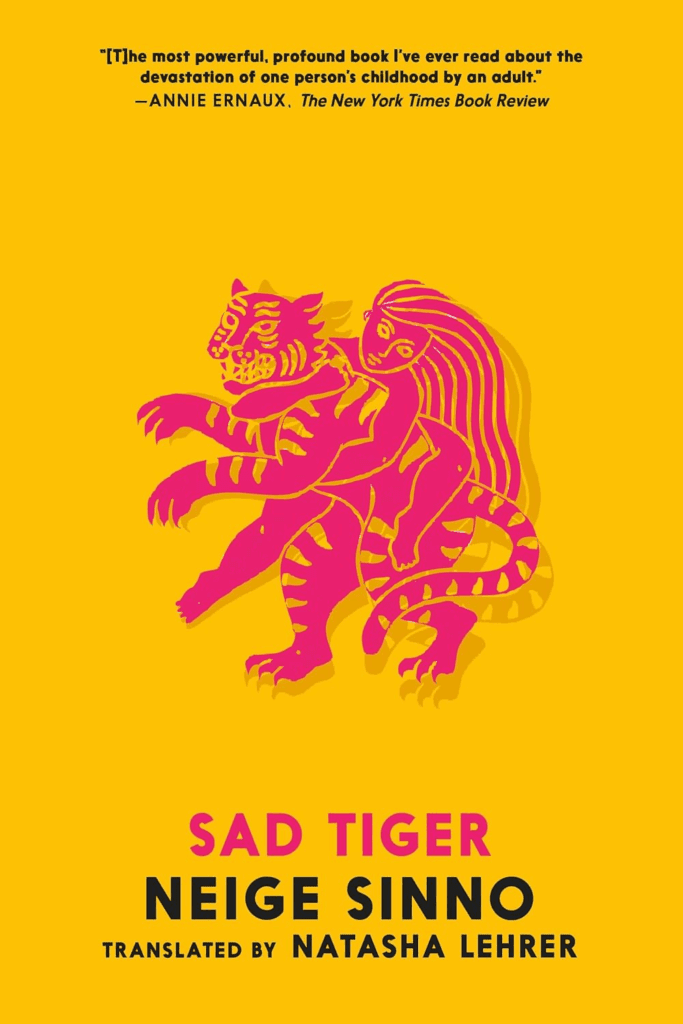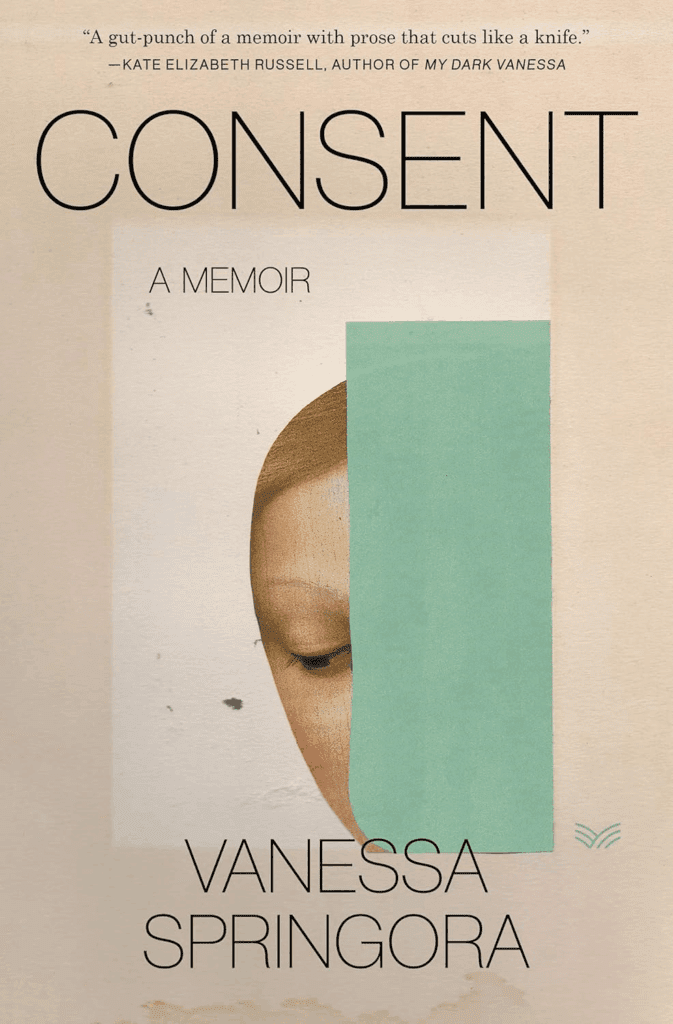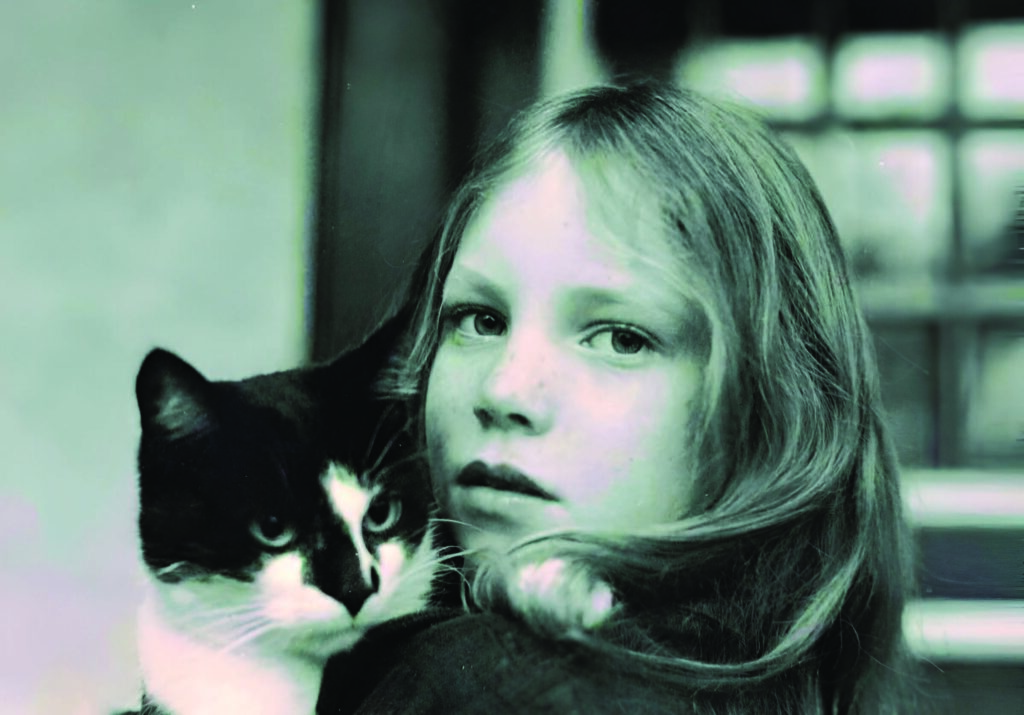
Voicing experiences of childhood sexual abuse counteracts the techniques perpetrators use to sustain their patterns of criminal abuse; namely, silencing the victim and controlling the narrative about what happened. Sad Tiger by Neige Sinno, recently published in an English translation by Natasha Lehrer, is an intelligent hybrid of survivor memoir and literary criticism. A sensation when published in France, it was shortlisted for the 2023 Prix Goncourt. Sad Tiger joins Consent by Vanessa Springora as well as the unbound story of Andrea Skinner—daughter of Alice Munro—told through letters and interviews in recent essays by Rachel Aviv, Anne Enright, and Skinner herself, to correct the record of each of their girlhoods.
Neige Sinno is the author of two novels, Le camion and La vie des rats, and a scholar of American literature. Born in 1977, she’s the daughter of two “neo-rural,” “hippie dropouts in the Alps” who had two daughters and separated soon thereafter. When Sinno was six, her mother married a new man with a military background who was quite the opposite of her pacifist, bohemian papa. They bought a dilapidated farmhouse, which they intended to renovate into a family home. Sinno and her younger sister Rose had a new stepfather, but not a new papa. Sinno writes,
I don’t want to call him papa. I already have a papa. I don’t need his love, his education, his hugs. I don’t want him to touch me. I don’t let him come near me. All he wants is for me to love him. He tries to get close to me. I push him away. So he comes at night and touches me . . .
At seven, her stepfather raped her. This continued until she was fourteen, and Sinno provides two views of how it stopped. First, the stepfather’s, from the transcript of his rape trial, where he implies he had an epiphany that he might be doing her permanent harm. Sinno’s account refutes this:
I have a very detailed recollection of the negotiations that led to him ending the abuse, and the issue of my mental dissociation had nothing to do with it. . . . I remember the conversation, I remember analyzing our relationship, telling him what I thought, facing him down: No, we do not have a special bond, you think you can get close to me, but it’s not me, it’s just my body.
In the table of contents, Sad Tiger’s two chapters, “Portraits” and “Ghosts,” and their section titles foretell the work’s emotional range, from candid (“Portrait of my rapist”), to wry (“My life as a succession of news items in the local paper”), to poetic (“What will you do then, O stolen heart?”), to solemn (“How I talked about it to my daughter”). While not exactly a trigger warning, the titles prepare us for what we are about to read.
Sinno comes to memoir as a novelist and literary critic. As she tells her dark, tangly story of intrafamilial sexual trauma, she tries to make meaning by analyzing texts by Virginia Woolf, Toni Morrison, Mary Gaitskill, Vladimir Nabokov, and others. She has contradictory feelings about reading literature that depicts rape, avoiding it or skipping ahead to the explicit scenes and experiencing “a kind of jubilation that I’ve made it through a moment in the book that I think I probably understand better than anyone.” Sad Tiger excerpts a scene from Toni Morrison’s 1970 novel The Bluest Eye. In it, eleven-year-old Pecola, washing dishes at the sink, is raped by her father, details that echo a scene Sinno narrated earlier:
I’m washing dishes while my mom is drinking tea with a friend. . . . I’m scrubbing the plates furiously with a double-sided sponge and thinking about what I could say: He’s been raping me ever since I was little. That’s why I hate him. All he does is rape me. . . . I’m walking a tight-rope between two cliffs, the world before I utter these words and the world after.
Sinno stays silent, knowing she has the power to destroy her family and holding it close. The first person she tells is her high school best friend. She finds support among university friends. In her early twenties, Sinno finally tells her mother, who listens, believes, files a police complaint with her daughter, and gets divorced. “Her life fell apart,” Sinno writes. “Everything she’d done up until then lost all meaning.”

Published in 2021 in a translation also by Natasha Lehrer, the international bestseller Consent recounts Parisian publisher Vanessa Springora’s involvement at fourteen with the fifty-year-old writer G., a fixture among France’s literary elite and a known pedophile who published accounts of his sexual abuse of children. Springora’s memoir pivots on her ensnarement in what she perceived to be a romantic relationship and her mother’s confusing response. The arc of her story involves her growing awareness that she wasn’t G.’s one special love, but one in a long sequence of children groomed by a practiced pedophile.
Springora is thirteen when her mother drags her to a dinner where she first encounters G. His pursuit starts with glances, flirting with the mother to secure a ride in the backseat with the daughter. He writes flowery letters, contrives chance encounters, invites her into his apartment, and, weeks after her fourteenth birthday, initiates sex. Springora tells her mother about him, and she asks, “Are you aware he’s a pedophile?” Her mother’s response is complex, ranging from disgust to incredulity to jealousy to acceptance. She threatens to send Springora to a boarding school but doesn’t follow through. Other adults fail to intervene, including Springora’s father and the physician to whom G. brings her for contraception, itself an illegal prescription given her age. Even as Springora recounts the bloom of first love, she recalls signs of rot that she noticed but couldn’t decipher at the time: G.’s preference for her basic cotton underwear, his whispers that she was “Just like a little boy,” and his incessant lectures on the topic of sex between adults and children.
Consent is a story of capture and liberation, summarized by its part titles: “The Child,” “The Prey,” “The Stranglehold,” “Release,” “The Imprint,” and “Writing.” Teenage Springora notices that what she thought was their special love was, in fact, G.’s pattern. She reads those of his books that he’d forbidden and is sickened by his accounts of sex with “young boys aged eleven or twelve.” On the street, she sees him “arm in arm with a girl.” Awareness heightened, her perspective shifts. “I now knew that his desire for me had been repeated an infinite number of times, was pathetically banal, and revealed a neurosis that took the form of an uncontrollable addiction.” When she perceives that G. had taken “possession of [her] youth for his sexual and literary ends,” she severs the relationship, but not without damage. Education interrupted, ambition drained, she’s depressed and not eating. She ends up hospitalized. “Mademoiselle,” the doctor says, “you have just experienced a psychotic episode, with a phase of depersonalization.”
Like Sinno, Springora provides social context for her story, leaving latitude for readers to draw conclusions about consent. She calls her mother a “feminist of the May ’68 generation,” invoking the “It is forbidden to forbid” sentiment of an anti-authoritarian era. In 1977 Le Monde published an open letter signed by intellectuals including Simone de Beauvoir and Jean-Paul Sartre arguing that thirteen-year-olds have the capacity to consent to sex with adults.
When Consent was published in 2020, France did not have a statutory rape law. A year later, partially in response to Springora’s book, French parliament unanimously passed a law defining sex with a person under fifteen as rape. Springora, without naming her prominent abuser, was able to vanquish him by writing and publishing her story. G., easily identifiable as Gabriel Matzneff, is currently under investigation for rape and facing legal action for promoting pedophilia.
The story of Andrea Robin Skinner, Alice Munro’s daughter, is told by Skinner in the Toronto Star and by Rachel Aviv in The New Yorker and Anne Enright in the New York Review of Books. The remarkable thing here is how much Skinner’s family knew about the abuse all along—evidenced in letters—and how Alice Munro was “protected” from this knowledge, thus sacrificing Skinner. Taken together with the new interviews and analysis of Munro’s fiction, these archival materials form a kind of superstory of what happened to Skinner as a child and how her story was told and untold, revealed and kept secret.

The youngest of Munro’s three daughters, Skinner was the only one still living at home in 1976. She spent school years in Victoria with her father, Jim Munro, and summers in Ontario with her mother and her stepfather, Gerald Fremlin. One night when she was nine and Munro was out of town, Fremlin sexually assaulted her. When Skinner returned to Victoria for school, she confided in her stepbrother and then told her stepmother, who told her father, Jim. He determined what happened next. Alice Munro’s ex-husband was the proprietor of Munro’s Books, a shop whose prominence had grown with her career. According to Anne Enright, “Jim Munro forbade his children to speak to their mother about Fremlin’s abuse,” because “it would kill her.” Jim Munro did not seem to trust Andrea Skinner’s version of events, commenting, “You know little girls, how they flirt and jump around.”
Then the family went silent about the topic. Skinner was blamed for being childishly flirtatious but the following summer, Jim Munro sent her back to Ontario with her sister Sheila as chaperone, a backhanded admission that Skinner was in danger of predation. And she was: Fremlin found opportunity to sexually abuse her for several more years. While Alice Munro hadn’t been told about the sexual abuse at that time, she had firsthand experience with Fremlin’s pedophilic philosophy. According to Rachel Aviv, “In front of Alice, [Fremlin] would tell Andrea that in the past, before the culture became prude, it had been ‘natural’ for adults to want to have sex with children.” He loved to reference Lolita. Fremlin’s pattern of behavior around children had raised suspicions and accusations. In the Toronto Star, Skinner writes, “Former friends of Fremlin’s told my mother that he’d exposed himself to their 14-year-old daughter.”
After years of migraines, insomnia, and bulimia, Andrea Skinner, now twenty-five, wrote to her mother detailing what Fremlin had done to her. Munro fled, leaving the letter for Fremlin to see. She felt humiliated by being left in the dark and betrayed by her husband. She did not express concern for Skinner. Fremlin attempted to control the narrative through a series of letters, “typed and copied in triplicate,” according to Enright’s piece. He blamed Skinner, calling her a “Lolita,” said he would kill himself, and threatened to distribute sexualized photographs he’d taken of her. He expressed regret only for having been unfaithful to Alice Munro. Soon the two were back together with Skinner more alienated than before.
Finally in 2004, upset by a New York Times Magazine profile in which Munro doted on Fremlin and lied about her close relationship with all her daughters, Andrea Skinner called the Ontario Police and filed charges. Fremlin’s letters became evidence. Aviv writes that the detective on the case “tried to interview Alice, but, he told me, ‘it was going nowhere. She was just disparaging her daughter.’” Fremlin pleaded guilty, avoiding a trial. The story didn’t make the news.
In the intervening years, Skinner’s three siblings sought support to process what had happened to their sister and the roles they had played in silencing her. They wrote to her and began the work of repairing their relationships.
The sisters were supportive when, two months after the death of their Nobel Prize–winning mother, Andrea Skinner went public with her account. While it was known within the family and even by some in Munro’s publishing circle, Skinner’s own telling of the sexual abuse, the family’s silencing of her, and Munro’s uncaring response startled the literary world and precipitated a flood of discourse and a new way to understand Munro’s oeuvre. In their literary analysis of Munro’s fiction, Aviv and Enright elucidate how denial and trauma, “incompletely assimilated,” recur in her short stories. “In Munro’s stories,” Enright says, “knowledge, which can feel like change, does not change anything.”
Resistance to facing this reality runs deep. Last year, the third-most-challenged book in libraries and schools was Toni Morrison’s The Bluest Eye. In her section titled “Reasons for not wanting to write this book,” Sinno dreads the totalizing nature of this revelation. “I don’t want to specialize in rape literature.” Further, she is not convinced that writing from “the eye of the storm” can help people heal. Perhaps a witness with objective distance, neither perpetrator nor victim, would be better positioned to write about incest in a way that has positive social impact, “but that is not the hand I was dealt.”
The cost of coming forward to Sinno, Springora, and Skinner was great. Is there a reward? Just this: these stories help us understand the indelible effects of childhood sexual trauma. They are stories that disempower perpetrators, explore a kind of cultural justice that goes beyond the ability of courts to punish, and model how affected families might reconfigure in a post-trauma reality. This is, it seems, knowledge that could, perhaps, lead to change.

